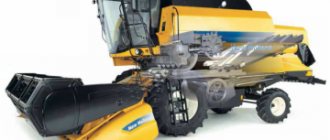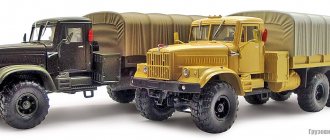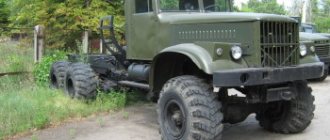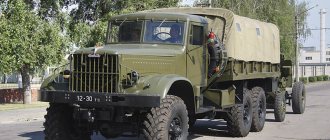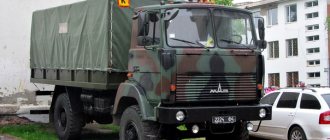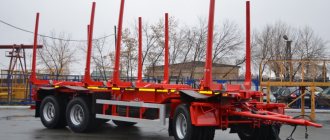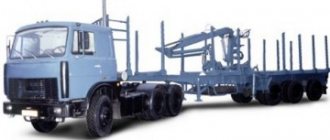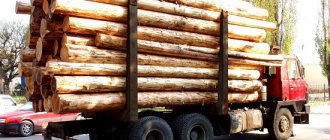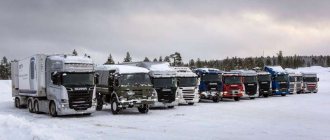Author: zaMKADpride
18 September 2022 08:32
Tags: KrAZ USSR cars all-terrain vehicles trucks laptezhnik equipment tractors
44204
7
The KrAZ-255B was nicknamed “Laptezhnik” for the wide-profile VI-3 tires of variable pressure installed on it. The car turned out to be a long-liver - it lasted on the assembly line for 26 years. During this time, 160,372 trucks were produced in various modifications and purposes.
0
Source:
See all photos in the gallery
In July 1967, the KrAZ-255B entered the assembly line of the Kremenchug Automobile Plant, where it remained until 1993. During this time, 160,732 vehicles of the KrAZ-255B/B1 family were produced, of which only in the export-tropical version the company sold more than 30 abroad 000 copies And how many chassis were exported as part of various special products is known only to the archives of the VO “Autoexport” and the secret departments of the State Committee for Electric Power Engineering of the USSR. The largest production of cars in this series occurred in 1978–1987, when 7,500–8,000 units rolled off the assembly line annually. The new product that appeared then differed little in appearance from its predecessor, the KrAZ-214B. The only thing that caught your eye was the wide tires installed on it, like bast shoes. This is where the nickname “laptezhnik” came from.
"Laptezhnik" on the conveyor
0
Source:
However, the centralized tire pressure control system had another advantage. In case of a puncture or bullet holes, it compensated for air leakage. The compressor maintained the required internal pressure in the tire, and the car could move in this mode for tens of kilometers. An important difference from its predecessor was the installation of a more powerful V-shaped 8-cylinder engine YaMZ-238 with a power of 240 hp. With. It made it possible to significantly improve the dynamics and traction properties of the car. Thus, the maximum speed increased from 55 to 70 km/h, and the load capacity from 7 to 7.5 tons. The KrAZ-255B served as the basis for various modifications and the base for the installation of various special equipment. Based on the KrAZ-255B, both conventional truck tractors (KrAZ255V) and a version for operation as part of an active road train (KrAZ-255D + MMZ-881) were developed. A modification of the KrAZ-255BS was prepared for operation in the Far North. As an experiment, they tried to install a GAZ-99 gas turbine power plant on the KrAZ-255B. By order of the military, the KrAZ-255BM army truck was developed. Its main difference was the use of a multi-fuel diesel engine.
Timber trucks KrAZ
Trucks for transporting timber of this brand are produced at the Kremenchug Automobile Plant. The company has been producing trucks since 1958. Until this point, the organization functioned as a bridge manufacturer. In 1956 and 1957, the company specialized in the production of agricultural machinery. In particular, corn harvesters and beet loaders were supplied to conveyor production.
Today KrAZ is engaged in the production of various cargo vehicles. Many models collected here are supplied to the armed forces of different countries. The timber trucks presented by this construction company stand out qualitatively against the background of competitive models. Such vehicles have a high potential for cross-country ability, thanks to which they are able to easily deliver cargo under any conditions.
Advantages and disadvantages
KrAZ timber trucks are distinguished by a high level of maneuverability and the ability to operate in various conditions. With maximum carrying capacity, we can talk about the efficiency of the vehicle. Thanks to the hood design, KrAZ timber trucks are ideal for logging work. The machine's cabin is located behind the engine, which is a good solution from the point of view of ensuring passive safety. In addition, the level of vibrations in the driver's seat is minimized. This method of placing the power plant also facilitates engine maintenance and repair work.
Separately, attention should be paid to the advantages of the implemented design solutions, which give the timber truck maximum strength and reliability. Thus, the spar frame is made of hot rolled channel. Thickened walls and powerful frame cross members make the entire structure as resistant to various loads as possible.
Bridges with cast beams are additionally reinforced. The gearboxes are equipped with reliable gears that are designed for maximum torque. The front and rear suspension are also reinforced, making it possible to overcome the most difficult road sections.
Among the problematic issues, you should pay attention to the hydraulic system installed in the brakes. Under intense maximum loads, it is not capable of operating for a long period of time. In this case, the problem is resolved quite simply - by installing components of the best quality. You can find them without any problems.
It should also be noted the low quality of standard tires. Standard tires are largely not designed for use on paved surfaces. For this reason, at the beginning of each season, it is advisable to carry out work on installing new tires.
Timber carrier KrAZ-255L (1969). The photo shows a later version
0
Source:
“Laptezhnik” served as the basis for the creation of the KrAZ-255L timber truck. When coupled with a TMZ-803 semi-trailer, the timber carrier could transport up to 40 m3 of wood and transport timber in logs from 18 to 30 m along clearings where previously only tracked skidders worked. Tankers (ATs-8.5-255B), equipment for tankers (TZA-8-255B), truck cranes (KS-3572) and excavators (EOV-4421), fire-fighting equipment, as well as special superstructures for orders from the oil industry. The vehicle was used as a trailer tow for transporting oversized cargo and aircraft at airports. The car played a special role in the troops. It was used to tow artillery systems, as well as missile systems. The chassis was used to install equipment for radio engineering air defense troops and a pontoon-bridge park (PMP).
Design features
The front suspension of KrAZ timber trucks is made on semi-elliptical longitudinal springs. The latter are equipped with double-acting telescopic shock absorbers. The rear suspension has a balancing design.
KrAZ timber trucks have different wheel arrangements - 6x4 or 6x6. Each of the bridges is unified. These elements have balanced axle shafts and a two-stage gearbox. The front axle is equipped with constant velocity joints. The need to use these elements is due to the possibility of transmitting torque to the drive wheels during a turn. The main design feature of the middle wheel axle is the presence of a special platform used to install an intermediate driveshaft support for the rear axle.
The power plant used may have different performance characteristics. In most cases, the engine is eight-cylinder. Two valves are installed on each cylinder.
The friction-type double-disc clutch is equipped with cylindrical pressure springs. The motor is aggregated by mechanical gearboxes with fixed shaft axles. Additionally, constant mesh gears are installed here.
The steering system of the vehicle is equipped with a piston-type hydraulic booster. The presence of this element facilitates the process of driving a vehicle.
The brake system of timber trucks is drum-type. Additionally, a pneumatic drive is installed, which helps to increase the reliability of the brakes. Also part of the braking system is a compression-type engine retarder and a parking brake.
Most models are equipped with an all-wheel drive system, which, in combination with short overhangs and a powerful power plant, ensures maximum vehicle cross-country ability. Timber trucks can be operated under different temperature conditions. This becomes possible thanks to the presence of an engine preheater.
Engineering technology. Chassis with piling equipment for organizing crossings
0
Source:
It’s worth dwelling on the latter in a little more detail. It was with the advent of the KrAZ-255B that it became much more compact and mobile. The PMP included 32 river units, four coastal units, four lining units and 16 towing boats. All this was placed on 54 single vehicles, instead of 98 Zils with trailers. For example, one KrAZ-255B transported one link, consisting of two middle and two outer pontoons, connected by hinge joints. In the transport position, the link was folded. The assembly of the floating bridge took place along the river. The KrAZ vehicles, lined up in a row, were reversing into the water. On command, each driver released the stopper securing the link to the car, and it slid down the rollers into the water. Then the link automatically unfolded within a minute. The further operation was to join each link into the bridge strip with the help of tugs. The time it took to erect a 60-ton bridge during the day was 30 minutes.
Review of popular models
In the model range presented by the Kremenchug Automobile Plant, there are various modifications of timber trucks. The operational characteristics of machines designed for transporting lumber and logs are determined by their design features.
KrAZ-64372
The KrAZ 64372 timber tractor is used to transport logging materials along roads with different surface qualities. This model is available in two different modifications. When using identical power plants, the machines have different dimensions. As a result, we can talk about different operational potential of cars.
Photo of timber truck KrAZ-64372
Both models have a 6x6 wheel arrangement and a hooded cab layout. Thanks to the last point, passive safety indicators are improved. Timber trucks are equipped with a comfortable driver's seat, which is adjustable according to the driver's wishes. The windshield of the car is made of separate sections. This moment negatively affects the quality of visibility.
The 64372 timber truck is equipped with a 14.86-liter power plant capable of producing 330 hp. The car has good dynamic characteristics.
Type 2 timber truck can accelerate to 72 km/h. Another variation of the model is capable of reaching speeds of up to 80 km/h. This becomes possible thanks to the lightweight weight of the vehicle.
The front and rear parts are equipped with a dependent balance-type suspension, which is mounted on semi-elliptical leaf springs. The brake system is equipped with drum-type mechanisms.
Technical characteristics of the KrAZ-64372 timber truck:
| Characteristics | 64372 type 1 | 64372 type 2 |
| Total weight, kg | 23000 | 27100 |
| Weight of the road train, kg | 43400 | 47000 |
| Weight of cargo in a road train, kg | 26200 | 30500 |
| Wheel formula | 6x6 | 6x6 |
| Engine: | ||
| — number of cylinders | 8 | 8 |
| — power, hp/kW | 330/243 | 330/243 |
| - fuel type | DT | DT |
| Gearbox type | mechanical, dual-range, eight-speed | mechanical, dual-range, eight-speed |
| Fuel tank, l | 250 (2) | 250 (2) |
| Maximum speed, km/h | 80 | 72 |
| Fuel consumption, l/100 km | 60 | 57 |
Video review of KrAZ timber trucks:
Excavator superstructure EOV-4421 on KrAZ-255B chassis
0
Source:
The PMP kit made it possible to connect two tapes: in parallel or in series. With a parallel connection, the width of the roadway was 6.5 m, which ensured two-way traffic. The carrying capacity of the bridge was 60 tons, the length was 227 m. With a series connection, the length of the bridge increased to 323 m, although its carrying capacity was reduced to 20 tons. In addition, a heavy mechanized bridge (TMM) was mounted on the KrAZ-255B chassis to establish crossings across narrow rivers. Its kit included four bridge laying machines. The length of the bridge truss of one vehicle in the open position was 10.5 m. From the kit it was possible to assemble bridge crossings up to 42 m long. On the KrAZ-255B, attachments for digging pits and self-digging of a single vehicle were tested - the topic “Perimeter” (KrAZ-E255BP, 1969). A knife for cutting soil was placed at the back. Lowering the knife into the working position was ensured by two hydraulic cylinders driven by a pump from the truck transmission. The cut soil fell onto a flexible canopy made from sections of conveyor belt that was trailing behind the rear of the machine.
Purpose and modifications
As noted above, the timber carrier was originally designed specifically for transporting military equipment and transporting soldiers. But soon the KRAZ 260 began to be supplied to agricultural enterprises, used as a carrier, tractor, and even a fire installation. Thanks to high-quality assembly and the possibility of additional equipment, the machine is universal and can simultaneously perform several tasks. Endurance and performance are two fundamental criteria for the creation of the KRAZ 260.
Kraz 260 is widely used at many logging enterprises
Over the entire history of the armored personnel carrier, about ten different models and modifications were produced.
Be sure to read: Kenworth T2000 tractors in Russia
Let's take a closer look at them:
- Standard KrAZ-260, which became the first vehicle of this series.
- KrAZ-260A with a special expanded fuel tank and a new diesel engine, which at that time was considered a real breakthrough in engine production.
- Powerful KRAZ 260V truck tractor with increased load capacity.
- KRAZ 260G on a new extended chassis.
- A special model designed for a road train, KrAZ-260D. It is important to note that only about twenty cars of this series were produced.
- In 1987, the USSR leadership launched mass production of the KRAZ-6437, which replaced all its predecessors.
- A unique water-jet unit KrAZ-260 “Tornado”, assembled in the early 2000s. Unfortunately, this model was never put into mass production, entering service with the Ukrainian army in several copies.
In addition to the main models, several additional units were created on the basis of the truck. For example, the special military excavator EOV-4422 of hydraulic type, the Grad multiple launch rocket system and the TMM 3M1 design. It is worth noting that these devices were released relatively recently and are today widely used by the Ukrainian army.
At some oil production enterprises you can find the AC-10-260 tank truck, the base of which is also the well-known KRAZ 260.
